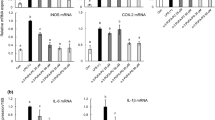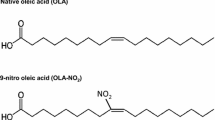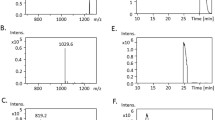Abstract
Lysophosphatidylcholine (lysoPtdCho) is a component of oxidized low density lipoprotein, and is involved in the pathogenesis of atherosclerosis and inflammation. We studied the effects of lysoPtdCho on cytotoxicity, reactive oxygen species (ROS) production, activation of the extracellular signal-regulated kinase (ERK), mitogen-activated protein kinases and pro-inflammatory gene expression in RAW 264.7 murine macrophage cells. When cells were exposed to lysoPtdCho with various acyl chains in a culture medium containing 10% fetal bovine serum, only 1-linoleoyl (C18:2) lysoPtdCho showed a remarkable cytotoxicity, reaching the highest level at 24 h, and elicited ROS production, suggesting that oxidative stress might be implicated in the cytotoxicity of 1-linoleoyl (C18:2) lysoPtdCho. Presumably in support of this, antioxidants such as magnolol or trolox prevented 1-linoleoyl (C18:2) lysoPtdCho-induced cytotoxicity as well as ROS production, although only partially. Furthermore, the phosphorylation of ERK 1/2 and the expression of pro-inflammatory cytokines such as IL-1β, CCL2 and CCL5 were augmented by 1-linoleoyl (C18:2) lysoPtdCho. Meanwhile, there was no structural importance of the acyl chain for the cytotoxic action of lysoPtdCho during 10 min incubation in serum-free media. Taken together, it is suggested that in a serum-containing medium, 1-linoleoyl (C18:2) lysoPtdCho can cause a significant cytotoxicity through ROS production, probably accompanied by activation of ERK and induction of related inflammatory cytokines, in RAW 264.7 cells.









Similar content being viewed by others
Abbreviations
- lysoPtdCho:
-
Lysophosphatidylcholine
- ROS:
-
Reactive oxygen species
- FBS:
-
Fetal bovine serum
- MTT:
-
3-(4,5-Dimethylthiazole-2-yl)-2,5-diphenyltetrazolium bromide
- ERK:
-
Extracellular signal-regulated kinase
- CCL:
-
Chemotactic cytokines ligand
References
Adibhatla Rao M, Hatcher JF (2006) Phospholipase A2, reactive oxygen species, and lipid peroxidation in cerebral ischemia. Free Radic Biol Med 40:376–387
Zalewski A, Macphee CH (2005) Role of lipoprotein-associated phospholipase A2 in atherosclerosis: biology, epidemiology, and possible therapeutic target. Arterioscler Thromb Vasc Biol 25:923–931
Daleau P (1999) Lysophosphatidylcholine, a metabolite which accumulates early in myocardium during ischemia, reduces gap junctional coupling in cardiac cells. J Mol Cell Cardiol 31:1391–1401
Silliman CC, Clay KL, Thurman GW, Johnson CA, Ambruso DR (1994) Partial characterization of lipids that develop during the routine storage of blood and prime the neutrophil NADPH oxidase. J Lab Clin Med 124:684–694
Thumser AE, Voysey JE, Wilton DC (1994) The binding of lysophospholipids to rat liver fatty acid-binding protein and albumin. Biochem J 301:801–806
Ojala PJ, Hermansson M, Tolvanen M, Polvenen K, Hirvonen T, Impola U, Jauhiainen M, Somerharju P, Parkkinen J (2006) Identification of alpha-1 acid glycoprotein as a lysophospholipid binding protein: a complementary role to albumin in the scavenging of lysophosphatidylcholine. Biochemistry 45:14021–14031
Kugiyama K, Sakamoto T, Misumi I, Sugiyama S, Ohgushi M, Ogawa H, Horiguchi M, Yasue H (1993) Transferable lipids in oxidized low-density lipoprotein stimulate plasminogen activator inhibitor-1 and inhibit tissue-type plasminogen activator release from endothelial cells. Circ Res 73:335–343
Huang F, Subbaiah PV, Holian O, Zhang J, Johnson A, Gertzberg N, Lum H (2005) Lysophosphatidylcholine increases endothelial permeability: role of PKC and RhoA cross talk. Am J Physiol Lung Cell Mol Physiol 289:L176–L185
Silliman CC, Elzi DJ, Ambruso DR, Musters RJ, Hamiel C, Harbeck RJ, Bjornsen AJ, Wyman TH, Kelher M, England KM, McLaughlin-Malaxecheberria N, Barnett CC, Aiboshi J, Bannerjee A (2003) Lysophosphatidylcholines prime the NADPH oxidase and stimulate multiple neutrophil functions through changes in cytosolic calcium. J Leukoc Biol 73:511–524
Nishioka H, Horiuchi H, Arai H, Kita T (1998) Lysophosphatidylcholine generates superoxide anions through activation of phosphatidylinositol 3-kinase in human neutrophils. FEBS Lett 441:63–66
Guyton KZ, Liu Y, Gorospe M, Xu Q, Holbrook NJ (1996) Activation of mitogen-activated protein kinase by H2O2. Role in cell survival following oxidant injury. J Biol Chem 271:4138–4142
Yamakawa T, Eguchi S, Yamakawa Y, Motley ED, Numaguchi K, Utsunomiya H, Inagami T (1998) Lysophosphatidylcholine stimulates MAP kinase activity in rat vascular smooth muscle cells. Hypertension 31:258–263
Liu-Wu Y, Hurt-Camejo E, Wiklund O (1998) Lysophosphatidylcholine induces the production of IL-1beta by human monocytes. Atherosclerosis 137:351–357
Quinn MT, Parthasarathy S, Steinberg D (1988) Lysophosphatidylcholine: a chemotactic factor for human monocytes and its potential role in atherogenesis. Proc Natl Acad Sci USA 85:2805–2809
Lauber K, Bohn E, Krober SM, Xiao YJ, Blumenthal SG, Lindemann RK, Marini P, Wiedig C, Zobywalski A, Baksh S, Xu Y, Autenrieth IB, Schulze-Osthoff K, Belka C, Stuhler G, Wesselborg S (2003) Apoptotic cells induce migration of phagocytes via caspase-3-mediated release of a lipid attraction signal. Cell 113:717–730
Ojala PJ, Hirvonen TE, Hermansson M, Somerharju P, Parkkinen J (2007) Acyl chain-dependent effect of lysophosphatidylcholine on human neutrophils. J Leukoc Biol 82:1501–1509
Perez-Gilabert M, Veldink GA, Vliegenthart JF (1998) Oxidation of dilinoleoyl phosphatidylcholine by lipoxygenase 1 from soybeans. Arch Biochem Biophys 354:18–23
Mosmann T (1983) Rapid colorimetric assay for cellular growth and survival: application to proliferation and cytotoxicity assays. J Immunol Methods 65:55–63
Oyama Y, Hayashi A, Ueha T, Meakawa K (1994) Characterization of 2′,7′-dichlorofluorescin fluorescence in dissociated mammalian brain neurons: estimation on intracellular content of hydrogen peroxide. Brain Res 635:113–117
Matsumoto T, Kobayashi T, Kamata K (2007) Role of lysophosphatidylcholine (LPC) in atherosclerosis. Curr Med Chem 14:3209–3220
Takeshita S, Inoue N, Gao D, Rikitake Y, Kawashima S, Tawa R, Sakurai H, Yokoyama M (2000) Lysophosphatidylcholine enhances superoxide anions production via endothelial NADH/NADPH oxidase. J Atheroscler Thromb 7:238–246
Kume N, Cybulsky MI, Gimborne MJ (1992) Lysophosphatidylcholine, a component of atherogenic lipoproteins, induces mononuclear leukocyte adhesion molecules in cultured human and rabbit arterial endothelial cells. J Clin Invest 90:1138–1144
Croset M, Brossard N, Polette A, Lagarde M (2000) Characterization of plasma unsaturated lysophosphatidylcholine in human and rat. Biochem J 345:61–67
Waring P (2005) Redox active calcium ion channels and cell death. Arch Biochem Biophys 434:33–42
Watanabe N, Zmijewski JW, Takabe W, Umezu-Goto M, Le Goffe C, Sekine A, Landar A, Watanabe A, Aoki J, Arai H, Kodama T, Murphy MP, Kalyanaraman R, Darley-Usmar VM, Noguchi N (2006) Activation of mitogen-activated protein kinases by lysophosphatidylcholine-induced mitochondrial reactive oxygen species generation in endothelial cells. Am J Pathol 168:1737–1748
Komatsu D, Kato M, Nakayama J, Miyagawa S, Kamata T (2008) NADPH oxidase 1 plays a critical mediating role in oncogenic Ras-induced vascular endothelial growth factor expression. Oncogene 102:1–9
Bergmann SR, Ferguson TB Jr, Sobel BE (1981) Effects of amphiphiles on erythrocytes, coronary arteries, and perfused hearts. Am J Physiol 240:H229–H237
Bierbaum TJ, Bouma SR, Huestis WH (1979) A mechanism of erythrocyte lysis by lysophosphatidylcholine. Biochim Biophys Acta 555:102–110
Portman OW, Alexander M (1969) Lysophosphatidylcholine concentrations and metabolism in aortic intima plus inner media: effect of nutritionally induced atherosclerosis. J Lipid Res 10:158–165
Kugiyama M, Kern SA, Morrisett JD, Roberts R, Henry PD (1990) Impairment of endothelium-dependent arterial relaxation by lysolecithin in modified low-density lipoproteins. Nature 344:160–162
Zhou L, Shi M, Guo Z, Brisbon W, Hoover R, Yang H (2006) Different cytotoxic injuries induced by lysophosphatidylcholine and 7-ketocholesterol in mouse endothelial cells. Endothelium 13:213–226
Li Z, Mintzer E, Bittman R (2004) The critical micelle concentrations of lysophosphatidic acid and sphingosylphosphorylcholine. Chem Phys Lipids 130:197–201
Kim YL, Im YJ, Ha NC, Im DS (2007) Albumin inhibits cytotoxic activity of lysophosphatidylcholine by direct binding. Prostaglandins Other Lipid Mediat 83:130–138
Weltzien HU, Arnold B, Reuther R (1977) Quantitative studies on lysolecithin-mediated hemolysis. Use of ether-deoxy lysolecithin analogs with varying aliphatic chain-lengths. Biochim Biophys Acta 466:411–421
Okita M, Gaudette DC, Mills GB, Holub BJ (1997) Elevated levels and altered fatty acid composition of plasma lysophosphatidylcholine (lysoPC) in ovarian cancer patients. Int J Cancer 71:31–40
Murugesan G, Sandhya Rani MR, Gerber CE, Mukhopadhyay C, Ransohoff RM, Chisolm GM, Kottke-Marchant K (2003) Lysophosphatidylcholine regulates human microvascular endothelial cell expression of chemokines. J Mol Cell Cardiol 35:1375–1384
Ozaki H, Ishii K, Arai H, Kume N, Kita T (1999) Lysophosphatidylcholine activates mitogen-activated protein kinases by a tyrosine kinase-dependent pathway in bovine aortic endothelial cells. Atherosclerosis 143:261–266
Feuerstein GZ, Young PR (2000) Apoptosis in cardiac disease: stress and mitogen-activated signaling pathways. Cardiovasc Res 45:560–569
Jing Q, Xin S-M, Zhang W-B, Wang P, Qin Y-W, Pei G (2000) Lysophosphatidylcholine activates p38 and p42/44 mitogen-activated protein kinases in monocytic THP-1 cells, but only p38 activation is involved in its stimulated chemotaxis. Circ Res 87:52–59
Acknowledgment
This work was financially supported by a Korea Research Foundation Grant funded by the Korean Government (MOEHRD) (KRF-2007-531-C00067), Korea.
Author information
Authors and Affiliations
Corresponding author
About this article
Cite this article
Park, C.H., Kim, M.R., Han, JM. et al. Lysophosphatidylcholine Exhibits Selective Cytotoxicity, Accompanied by ROS Formation, in RAW 264.7 Macrophages. Lipids 44, 425–435 (2009). https://doi.org/10.1007/s11745-009-3286-6
Received:
Accepted:
Published:
Issue Date:
DOI: https://doi.org/10.1007/s11745-009-3286-6




